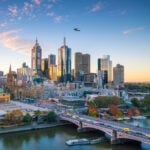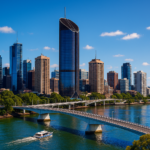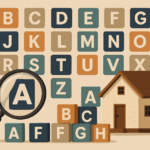
Key takeaways
House rents flatlining: House rents remain at record highs in all capitals except Darwin - but growth is stalling. Sydney, Melbourne and Brisbane recorded their slowest June quarter growth in years, with near zero movement in price.
Perth surges alongside Canberra as second most expensive: A $5 weekly rise has put Perth equal second with Canberra as the most expensive cities to rent a house, now just behind Sydney.
Price growth shifts to units: Unit rents are at record highs across all capitals, and growth in unit prices is outpacing houses in all cities except in Melbourne – driven by affordability pressures and shifting renter preferences.
Renters still face tough competition: Despite a slight easing in some cities, national vacancy rates are still below 2%. Darwin is the tightest market in the country, with a vacancy rate of just 0.3%.
Rental price rises in most major capitals are either stalling or seeing their slowest growth in years, according to the latest Domain Rental Report.
This is the first time since 2019 that house rents across the combined capitals have remained stable for four consecutive quarters, signalling a clear turning point in the rental cycle.
Domain’s Chief of Research and Economics, Dr Nicola Powell said:
“Cost of living pressures have reached a tipping point. Renters are maxed out and landlords are being forced to hold steady.
We’re also seeing a shift in demand - renters are downsizing or choosing units to stretch their budgets, which is why unit rents are now rising faster than houses.
While competition remains tough, early signs of investor activity and first-home buyer support could slowly help ease supply pressures and rebalance the market.”
Houses
Table 1: House rents, quarterly and annual changes
| HOUSES | MEDIAN RENTAL ASKING PRICE | ||||||
| Capital City | Jun-25 | Mar-25 | Jun-24 | Quarterly change | Annual change | Status |
| Sydney | $780 | $775 | $759 | 0.6% | 2.8% | Record (new) |
| Melbourne | $580 | $580 | $580 | 0.0% | 0.0% | Record (steady) |
| Brisbane | $650 | $650 | $630 | 0.0% | 3.2% | Record (steady) |
| Adelaide | $620 | $620 | $595 | 0.0% | 4.2% | Record (steady) |
| Perth | $700 | $695 | $650 | 0.7% | 7.7% | Record (new) |
| Canberra | $700 | $700 | $685 | 0.0% | 2.2% | Record (steady) |
| Darwin | $680 | $700 | $660 | -2.9% | 3.0% | $20 lower than Mar-25 record |
| Hobart | $570 | $570 | $540 | 0.0% | 5.6% | Record (steady) |
| Combined Capitals | $650 | $650 | $650 | 0.0% | 0.0% | Record (steady) |
- It is the weakest June quarter since 2019 in Darwin, since 2020 in Brisbane and Adelaide and since 2021 in Sydney and Melbourne.
- Annual gains have slipped to multi-year lows across many cities. It is the slowest growth in five years in Sydney and Adelaide, almost five years in Brisbane, almost four years in Melbourne and one year in Darwin.
Units
Table 2: Unit rents, quarterly and annual changes
| UNITS | MEDIAN RENTAL ASKING PRICE | ||||||
| Capital City | Jun-25 | Mar-25 | Jun-24 | Quarterly change | Annual change | Status |
| Sydney | $740 | $725 | $720 | 2.1% | 2.8% | Record (new) |
| Melbourne | $575 | $575 | $550 | 0.0% | 4.5% | Record (steady) |
| Brisbane | $620 | $615 | $600 | 0.8% | 3.3% | Record (new) |
| Adelaide | $523 | $500 | $480 | 4.5% | 8.9% | Record (new) |
| Perth | $620 | $600 | $550 | 3.3% | 12.7% | Record (new) |
| Canberra | $580 | $575 | $560 | 0.9% | 3.6% | Record (new) |
| Darwin | $560 | $560 | $540 | 0.0% | 3.7% | Record (steady) |
| Hobart | $500 | $480 | $450 | 4.2% | 11.1% | Record (new) |
| Combined Capitals | $650 | $650 | $630 | 0.0% | 3.2% | Record (steady) |
- Sydney, Brisbane and Melbourne delivered their weakest June quarter since 2021. By contrast, Adelaide posted its strongest June quarter since 2005, Hobart since 2009, Canberra since 2022 and Perth since 2023.
- Annual growth has fallen to its lowest point in more than four years in Brisbane and almost four years in Sydney, while Melbourne is at just over a three-year low. Conversely, Canberra and Hobart recorded their fastest annual gains in 2.5 years.
Vacancy rate
Table 3: House and unit combined rental vacancy rates
| HOUSE AND UNIT COMBINED | RENTAL VACANCY RATES | |||||
| Capital City | Jun-25 | Mar-25 | Jun-24 | Quarterly percentage point change | Annual percentage point change |
| Sydney | 1.1% | 0.9% | 1.2% | 0.2 ppt | -0.1 ppt |
| Melbourne | 1.3% | 1.2% | 1.2% | 0.1 ppt | 0.1 ppt |
| Brisbane | 0.7% | 0.8% | 0.9% | -0.1 ppt | -0.2 ppt |
| Perth | 0.5% | 0.4% | 0.6% | 0.1 ppt | -0.1 ppt |
| Adelaide | 0.5% | 0.4% | 0.5% | 0.1 ppt | 0.0 ppt |
| Hobart | 0.4% | 0.4% | 1.0% | 0.0 ppt | -0.6 ppt |
| Canberra | 1.1% | 1.2% | 1.7% | -0.1 ppt | -0.6 ppt |
| Darwin | 0.3% | 0.6% | 0.7% | -0.3 ppt | -0.4 ppt |
| Combined Capitals | 0.9% | 0.9% | 1.0% | 0.0 ppt | -0.1 ppt |
| Combined Regionals | 0.7% | 0.9% | 0.8% | -0.2 ppt | -0.1 ppt |
| National | 0.8% | 1.3% | 0.7% | -0.5 ppt | 0.1 ppt |
According to the report, vacancy remains tight – sub-2% everywhere – and, despite modest winter rises, supply is still well short of demand.
Dr Powell further said:
Investor lending has picked up year-on-year, which should eventually release more available rental, and federal schemes such as the expanded Help to Buy program may ease pressure by moving some renters into ownership.
Even so, with new-build pipelines thin and population growth resilient, a return to balanced conditions will likely be slow – though this quarter’s broad-based deceleration suggests the first steps toward that balance are finally underway."














